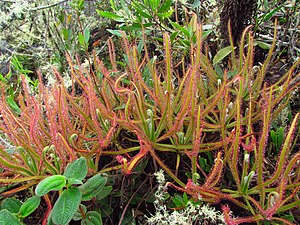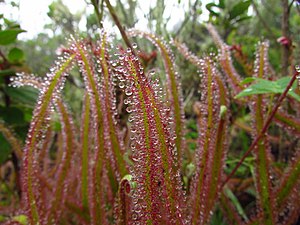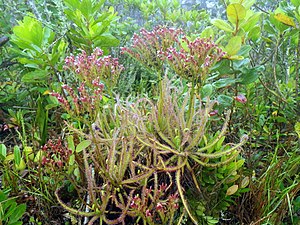Magnificent sundew
| Magnificent sundew | ||||||||||||
|---|---|---|---|---|---|---|---|---|---|---|---|---|

Magnificent Sundew ( Drosera magnifica ) |
||||||||||||
| Systematics | ||||||||||||
|
||||||||||||
| Scientific name | ||||||||||||
| Drosera magnifica | ||||||||||||
| Rivadavia & Gonella |
The Magnificent Sonnentau ( Drosera magnifica ) is a plant from the genus sundew ( Drosera ) in the family of Sundew Family (Droseraceae).
This carnivorous plant is endemic to the Brazilian state of Minas Gerais .
description
Vegetative characteristics
Drosera magnifica is a perennial herbaceous plant . There is a basal leaf rosette and a leafless, runners-like stem axis that reaches a maximum length of 123.5 centimeters and grows prostrate or, supported by the surrounding vegetation, ascending. The stem is unbranched or simply branched. The branch of the basal side shoot is covered by the remaining, dried up leaves from the previous year. The roots are succulent , black in color and only slightly branched.
With a length of 100 to 240 millimeters and a width of only 3 to 8 millimeters, the green-colored leaves are linear-lanceolate with a pointed upper end, the edge of the leaf blade is rolled up when the leaves are ripe. Ripe leaves are sessile, young ones have a recognizable petiole. The membranous, golden-brown stipules are triangular with a maximum length of 15 millimeters.
Indument
The above-ground parts of the plant are partially covered by an indument of white, non-glandular hairs about 4 millimeters long that are golden yellow on dried specimens ; these are located at the base of the underside of the leaf, on the entire upper side of the leaf, stem axis, flower stalk and sepals . Stalked heady glandular hairs only reach a maximum of 0.5 millimeters in length, they sit on the stem axis, the flower stalks and sepals. The leaf surface has numerous small, sessile glands. The insect-catching glandular hairs typical of the genus are located on the upper side of the leaf, they are red-colored, long-stalked, heady glandular hairs.
Generative characteristics
The zymous inflorescence , which is usually richly branched with six to ten branches at the top, reaches a height of 165 to 350 millimeters and contains 17 to 190 flowers. There are decrepit, relatively small bracts . The flower stalks are 2.5 to 7 millimeters long.
As far as is known, the flowering period extends from October to December. The hermaphroditic flowers are radial symmetry and five-fold with a double flower envelope . The five sepals are oblong, up to 8 millimeters in length, obovate to ovate and are pink-white in color during anthesis . The five petals are 8 to 10 millimeters in length, obovate and tinted light pink. The anthers are yellow. On the green, spherical ovary are three pen.
Occurrence and endangerment
So far, Drosera magnifica has only been found in the summit area of Pico do Padre Ângelo, Conselheiro Pena municipality, in the east of the Brazilian state of Minas Gerais , at an altitude of about 1500 meters. It grows in a grassy to shrubby savannah vegetation known locally as “campos rupestres” (in transition to “campos de altitude”) in sandy soil that is rich in vegetation and covers massive sandstone rocks . Most of the specimens grow close together in a tiny, south-facing clearing that is only 50 by 50 meters in size. The subsoil is not waterlogged, but the site receives a strong influx of moisture from moist air rising on the mountain slopes.
Due to its extremely small, micro-endemic distribution area, Drosera magnifica was rated as “critically endangered” according to the IUCN criteria when it was discovered . The only location is by cattle pastures, coffee and Eucalyptus - plantations and entrained plant species ( neophytes threatened).
particularities
Drosera magnifica is one of the three largest Drosera species. The other two are the king sundew ( Drosera regia ) from South Africa and Drosera gigantea from Australia . Brazil is home to around 30 of the total of around 250 Drosera species, including the similar and probably closest related Drosera graminifolia and Drosera spiralis .
The discovery of Drosera magnifica is remarkable; it is the first plant species discovered through a photo on Facebook . The orchid lover Reginaldo Vasconcelos photographed the plant as a new species in 2012. After the later first descriptors discovered the photo on the internet, they got in touch with Vasconcelos and in 2013 undertook a trip to the site where the material for the first scientific description was obtained.
The larva of the hover fly Toxomerus basalis lives on this and five related sundew species . It specializes in collecting insect prey caught by the plant and using it for its own nutrition ( kleptoparasitism ). The larvae spend their entire life on the plants, where they crawl around between the catch hairs, which are harmless to them due to a secreted aqueous secretion.
swell
- Paulo Minatel Gonella, Fernando Rivadavia, Andreas Fleischmann: Drosera magnifica (Droseraceae): the largest New World sundew, discovered on Facebook. Phytotaxa , Volume 220, Issue 3, 2015, pp. 257-267. doi : 10.11646 / phytotaxa.220.3.4
Individual evidence
- ↑ Andreas Fleischmann, Fernando Rivadavia, Paulo M. Gonella, Celeste Pérez-Bañón, Ximo Mengual, Santos Rojo: Where Is My Food? Brazilian Flower Fly Steals Prey from Carnivorous Sundews in a Newly Discovered Plant-Animal Interaction. In: PLoS ONE , 11, 5, e0153900, 2016. doi : 10.1371 / journal.pone.0153900 (open access)

